Analysis of Accounting Practices and Financial Reporting
VerifiedAdded on 2020/04/01
|13
|2895
|163
Report
AI Summary
This report provides a comprehensive analysis of accounting practices, financial reporting, and the treatment of heritage assets. Part A explores the role of measurement and bureaucratic processes in generating economic measurements, the importance of adhering to accounting standards, the concept of depreciation, the definition of income, the significance of financial statements, and the application of Generally Accepted Accounting Principles (GAAP). Part B delves into the deterioration of accounting practices, emphasizing the over-reliance on rules, the decline in professional intellectual leadership, and the impact of these issues on the reliability of financial information. Part C discusses the definition and accounting treatment of heritage assets, including their characteristics, asset and liability aspects, and disclosure requirements. The report highlights the challenges and complexities within the accounting profession, offering insights into the need for improved practices and the proper valuation and reporting of assets.
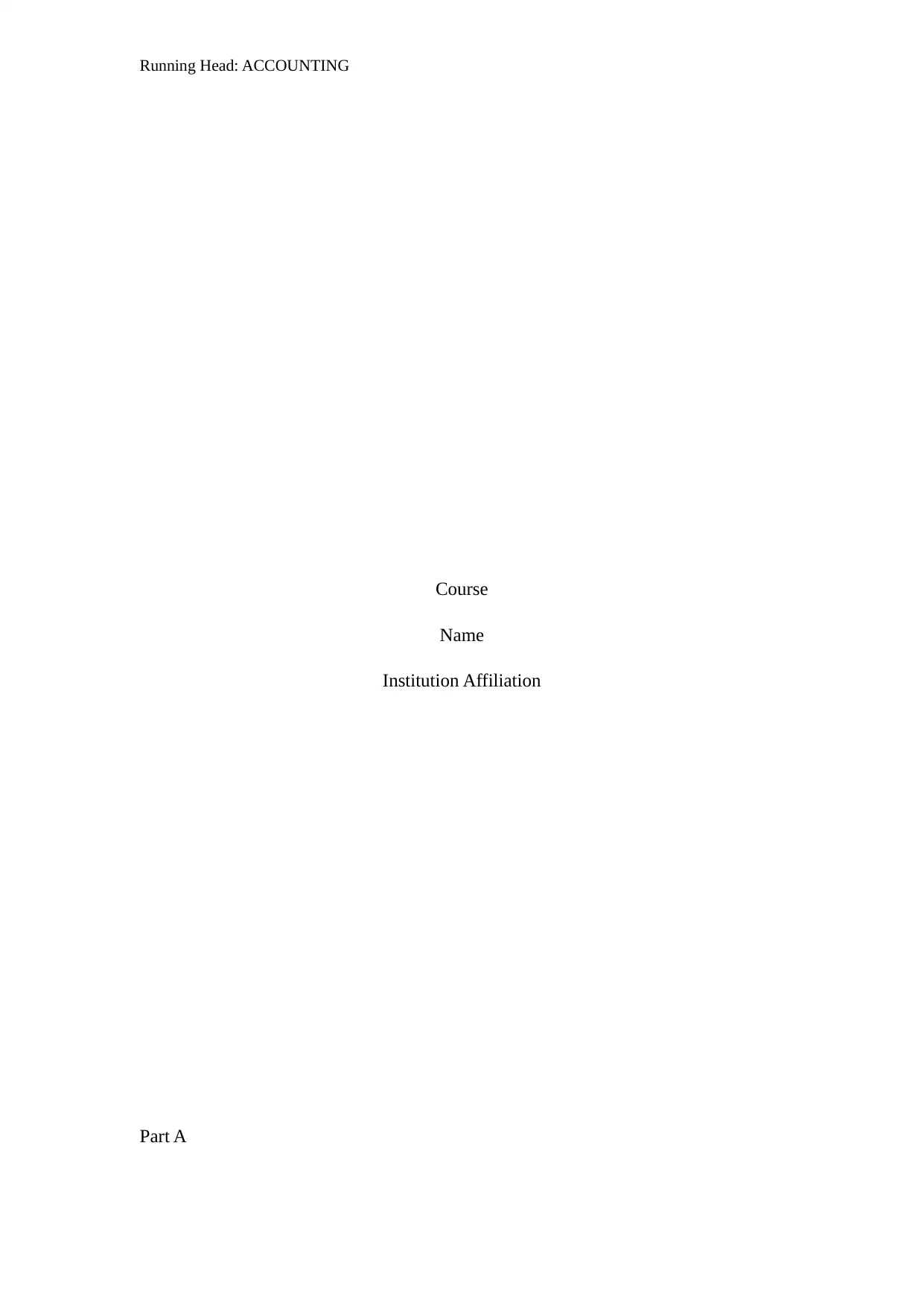
Running Head: ACCOUNTING
Course
Name
Institution Affiliation
Part A
Course
Name
Institution Affiliation
Part A
Paraphrase This Document
Need a fresh take? Get an instant paraphrase of this document with our AI Paraphraser
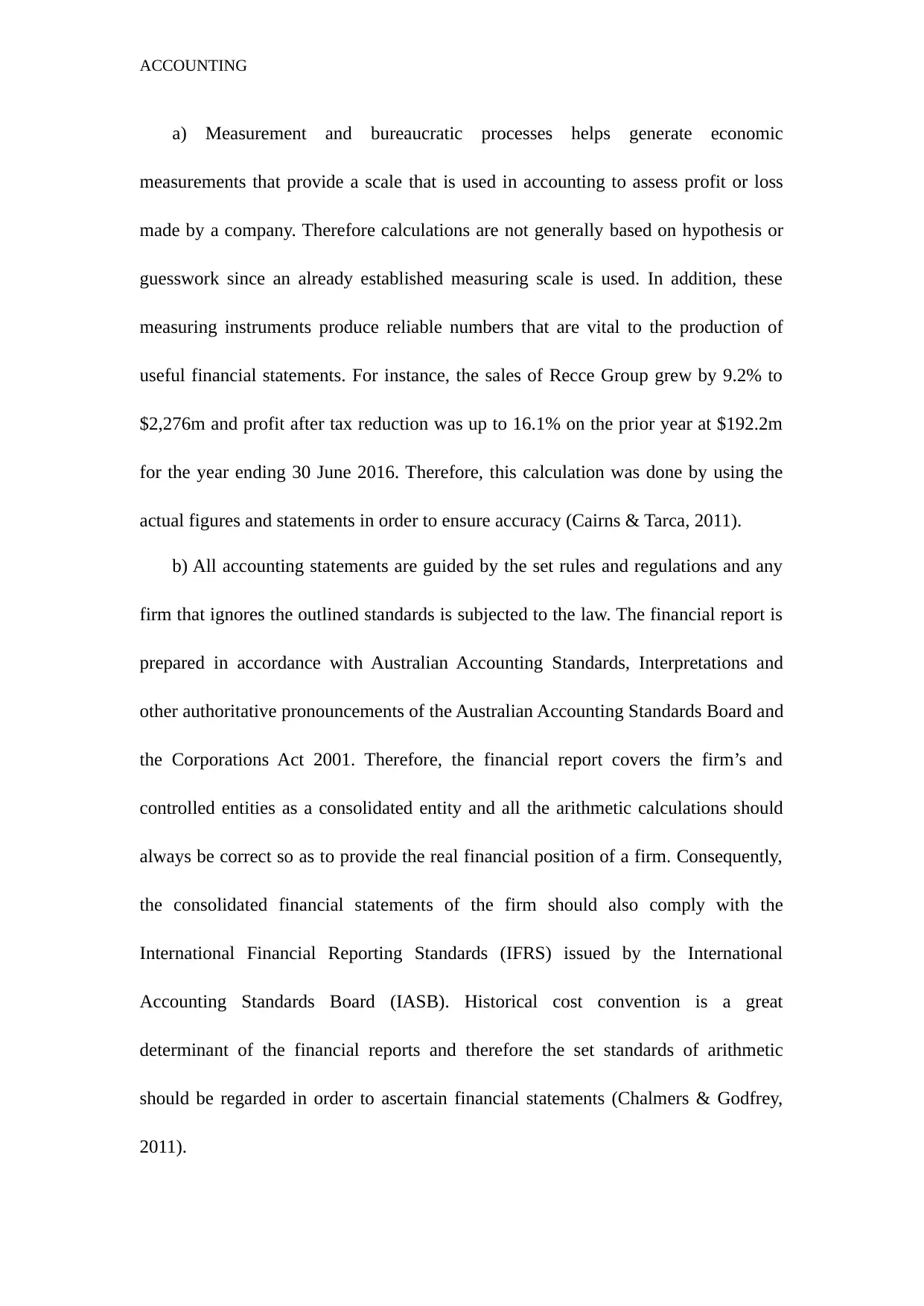
ACCOUNTING
a) Measurement and bureaucratic processes helps generate economic
measurements that provide a scale that is used in accounting to assess profit or loss
made by a company. Therefore calculations are not generally based on hypothesis or
guesswork since an already established measuring scale is used. In addition, these
measuring instruments produce reliable numbers that are vital to the production of
useful financial statements. For instance, the sales of Recce Group grew by 9.2% to
$2,276m and profit after tax reduction was up to 16.1% on the prior year at $192.2m
for the year ending 30 June 2016. Therefore, this calculation was done by using the
actual figures and statements in order to ensure accuracy (Cairns & Tarca, 2011).
b) All accounting statements are guided by the set rules and regulations and any
firm that ignores the outlined standards is subjected to the law. The financial report is
prepared in accordance with Australian Accounting Standards, Interpretations and
other authoritative pronouncements of the Australian Accounting Standards Board and
the Corporations Act 2001. Therefore, the financial report covers the firm’s and
controlled entities as a consolidated entity and all the arithmetic calculations should
always be correct so as to provide the real financial position of a firm. Consequently,
the consolidated financial statements of the firm should also comply with the
International Financial Reporting Standards (IFRS) issued by the International
Accounting Standards Board (IASB). Historical cost convention is a great
determinant of the financial reports and therefore the set standards of arithmetic
should be regarded in order to ascertain financial statements (Chalmers & Godfrey,
2011).
a) Measurement and bureaucratic processes helps generate economic
measurements that provide a scale that is used in accounting to assess profit or loss
made by a company. Therefore calculations are not generally based on hypothesis or
guesswork since an already established measuring scale is used. In addition, these
measuring instruments produce reliable numbers that are vital to the production of
useful financial statements. For instance, the sales of Recce Group grew by 9.2% to
$2,276m and profit after tax reduction was up to 16.1% on the prior year at $192.2m
for the year ending 30 June 2016. Therefore, this calculation was done by using the
actual figures and statements in order to ensure accuracy (Cairns & Tarca, 2011).
b) All accounting statements are guided by the set rules and regulations and any
firm that ignores the outlined standards is subjected to the law. The financial report is
prepared in accordance with Australian Accounting Standards, Interpretations and
other authoritative pronouncements of the Australian Accounting Standards Board and
the Corporations Act 2001. Therefore, the financial report covers the firm’s and
controlled entities as a consolidated entity and all the arithmetic calculations should
always be correct so as to provide the real financial position of a firm. Consequently,
the consolidated financial statements of the firm should also comply with the
International Financial Reporting Standards (IFRS) issued by the International
Accounting Standards Board (IASB). Historical cost convention is a great
determinant of the financial reports and therefore the set standards of arithmetic
should be regarded in order to ascertain financial statements (Chalmers & Godfrey,
2011).
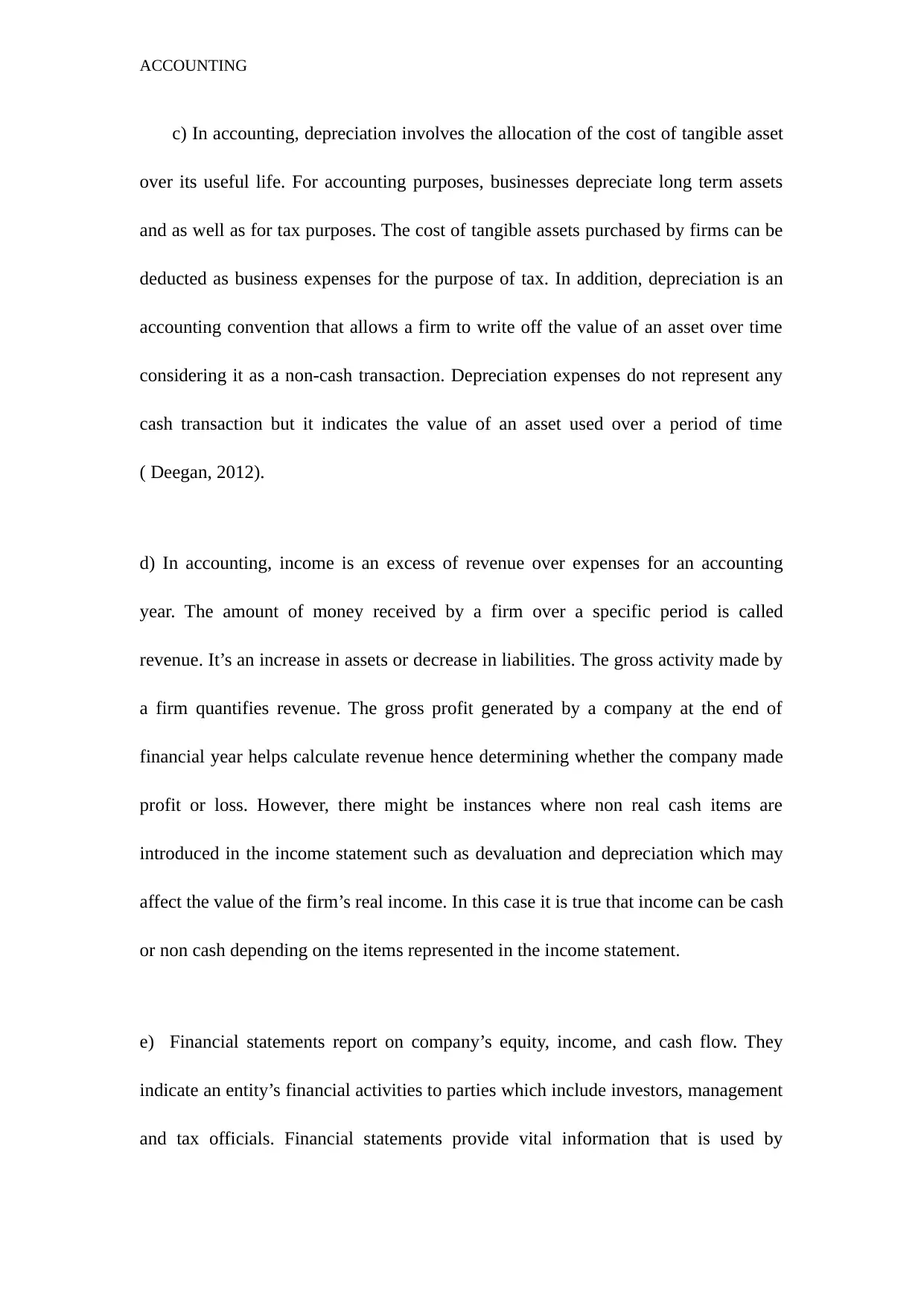
ACCOUNTING
c) In accounting, depreciation involves the allocation of the cost of tangible asset
over its useful life. For accounting purposes, businesses depreciate long term assets
and as well as for tax purposes. The cost of tangible assets purchased by firms can be
deducted as business expenses for the purpose of tax. In addition, depreciation is an
accounting convention that allows a firm to write off the value of an asset over time
considering it as a non-cash transaction. Depreciation expenses do not represent any
cash transaction but it indicates the value of an asset used over a period of time
( Deegan, 2012).
d) In accounting, income is an excess of revenue over expenses for an accounting
year. The amount of money received by a firm over a specific period is called
revenue. It’s an increase in assets or decrease in liabilities. The gross activity made by
a firm quantifies revenue. The gross profit generated by a company at the end of
financial year helps calculate revenue hence determining whether the company made
profit or loss. However, there might be instances where non real cash items are
introduced in the income statement such as devaluation and depreciation which may
affect the value of the firm’s real income. In this case it is true that income can be cash
or non cash depending on the items represented in the income statement.
e) Financial statements report on company’s equity, income, and cash flow. They
indicate an entity’s financial activities to parties which include investors, management
and tax officials. Financial statements provide vital information that is used by
c) In accounting, depreciation involves the allocation of the cost of tangible asset
over its useful life. For accounting purposes, businesses depreciate long term assets
and as well as for tax purposes. The cost of tangible assets purchased by firms can be
deducted as business expenses for the purpose of tax. In addition, depreciation is an
accounting convention that allows a firm to write off the value of an asset over time
considering it as a non-cash transaction. Depreciation expenses do not represent any
cash transaction but it indicates the value of an asset used over a period of time
( Deegan, 2012).
d) In accounting, income is an excess of revenue over expenses for an accounting
year. The amount of money received by a firm over a specific period is called
revenue. It’s an increase in assets or decrease in liabilities. The gross activity made by
a firm quantifies revenue. The gross profit generated by a company at the end of
financial year helps calculate revenue hence determining whether the company made
profit or loss. However, there might be instances where non real cash items are
introduced in the income statement such as devaluation and depreciation which may
affect the value of the firm’s real income. In this case it is true that income can be cash
or non cash depending on the items represented in the income statement.
e) Financial statements report on company’s equity, income, and cash flow. They
indicate an entity’s financial activities to parties which include investors, management
and tax officials. Financial statements provide vital information that is used by
⊘ This is a preview!⊘
Do you want full access?
Subscribe today to unlock all pages.

Trusted by 1+ million students worldwide
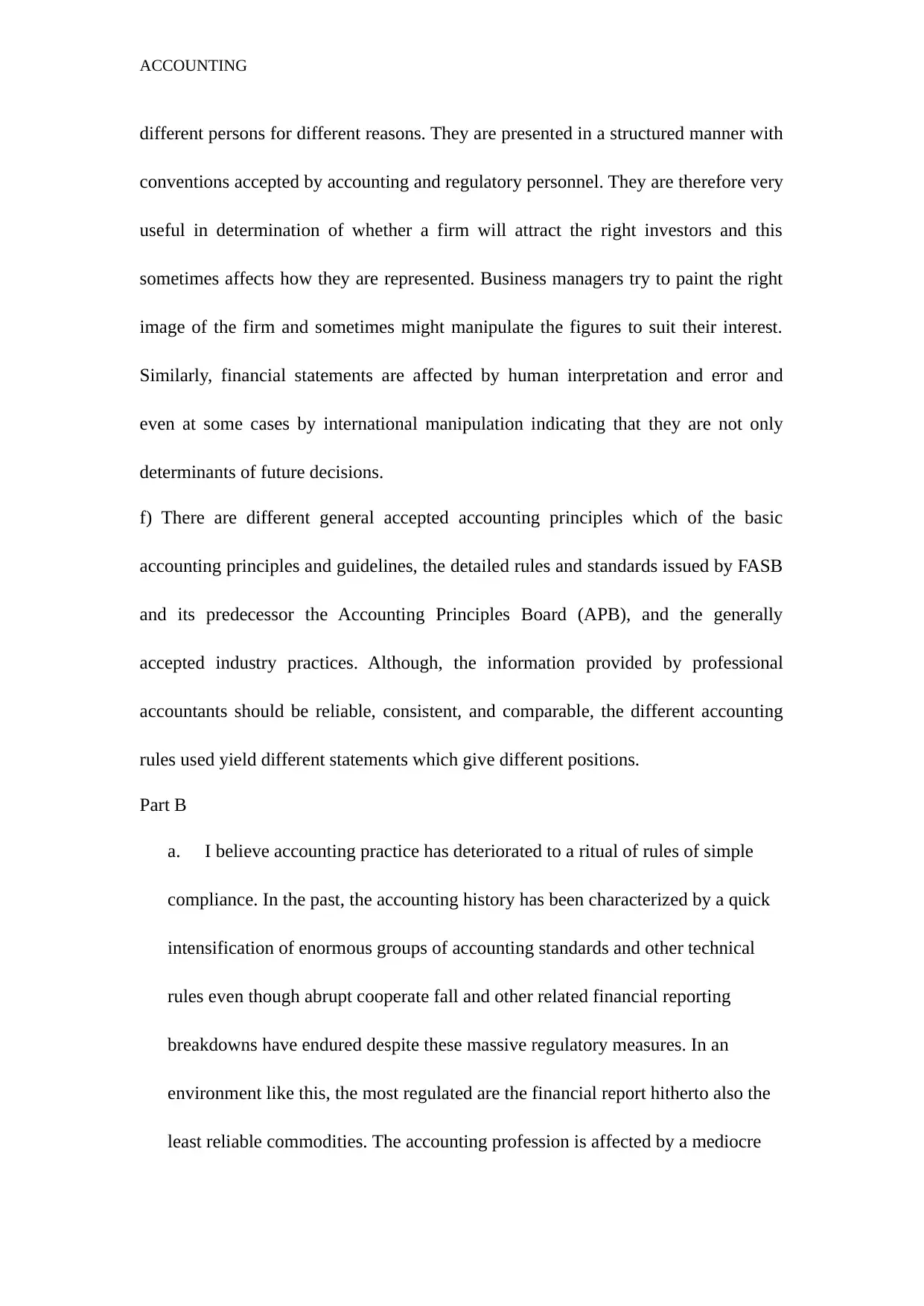
ACCOUNTING
different persons for different reasons. They are presented in a structured manner with
conventions accepted by accounting and regulatory personnel. They are therefore very
useful in determination of whether a firm will attract the right investors and this
sometimes affects how they are represented. Business managers try to paint the right
image of the firm and sometimes might manipulate the figures to suit their interest.
Similarly, financial statements are affected by human interpretation and error and
even at some cases by international manipulation indicating that they are not only
determinants of future decisions.
f) There are different general accepted accounting principles which of the basic
accounting principles and guidelines, the detailed rules and standards issued by FASB
and its predecessor the Accounting Principles Board (APB), and the generally
accepted industry practices. Although, the information provided by professional
accountants should be reliable, consistent, and comparable, the different accounting
rules used yield different statements which give different positions.
Part B
a. I believe accounting practice has deteriorated to a ritual of rules of simple
compliance. In the past, the accounting history has been characterized by a quick
intensification of enormous groups of accounting standards and other technical
rules even though abrupt cooperate fall and other related financial reporting
breakdowns have endured despite these massive regulatory measures. In an
environment like this, the most regulated are the financial report hitherto also the
least reliable commodities. The accounting profession is affected by a mediocre
different persons for different reasons. They are presented in a structured manner with
conventions accepted by accounting and regulatory personnel. They are therefore very
useful in determination of whether a firm will attract the right investors and this
sometimes affects how they are represented. Business managers try to paint the right
image of the firm and sometimes might manipulate the figures to suit their interest.
Similarly, financial statements are affected by human interpretation and error and
even at some cases by international manipulation indicating that they are not only
determinants of future decisions.
f) There are different general accepted accounting principles which of the basic
accounting principles and guidelines, the detailed rules and standards issued by FASB
and its predecessor the Accounting Principles Board (APB), and the generally
accepted industry practices. Although, the information provided by professional
accountants should be reliable, consistent, and comparable, the different accounting
rules used yield different statements which give different positions.
Part B
a. I believe accounting practice has deteriorated to a ritual of rules of simple
compliance. In the past, the accounting history has been characterized by a quick
intensification of enormous groups of accounting standards and other technical
rules even though abrupt cooperate fall and other related financial reporting
breakdowns have endured despite these massive regulatory measures. In an
environment like this, the most regulated are the financial report hitherto also the
least reliable commodities. The accounting profession is affected by a mediocre
Paraphrase This Document
Need a fresh take? Get an instant paraphrase of this document with our AI Paraphraser
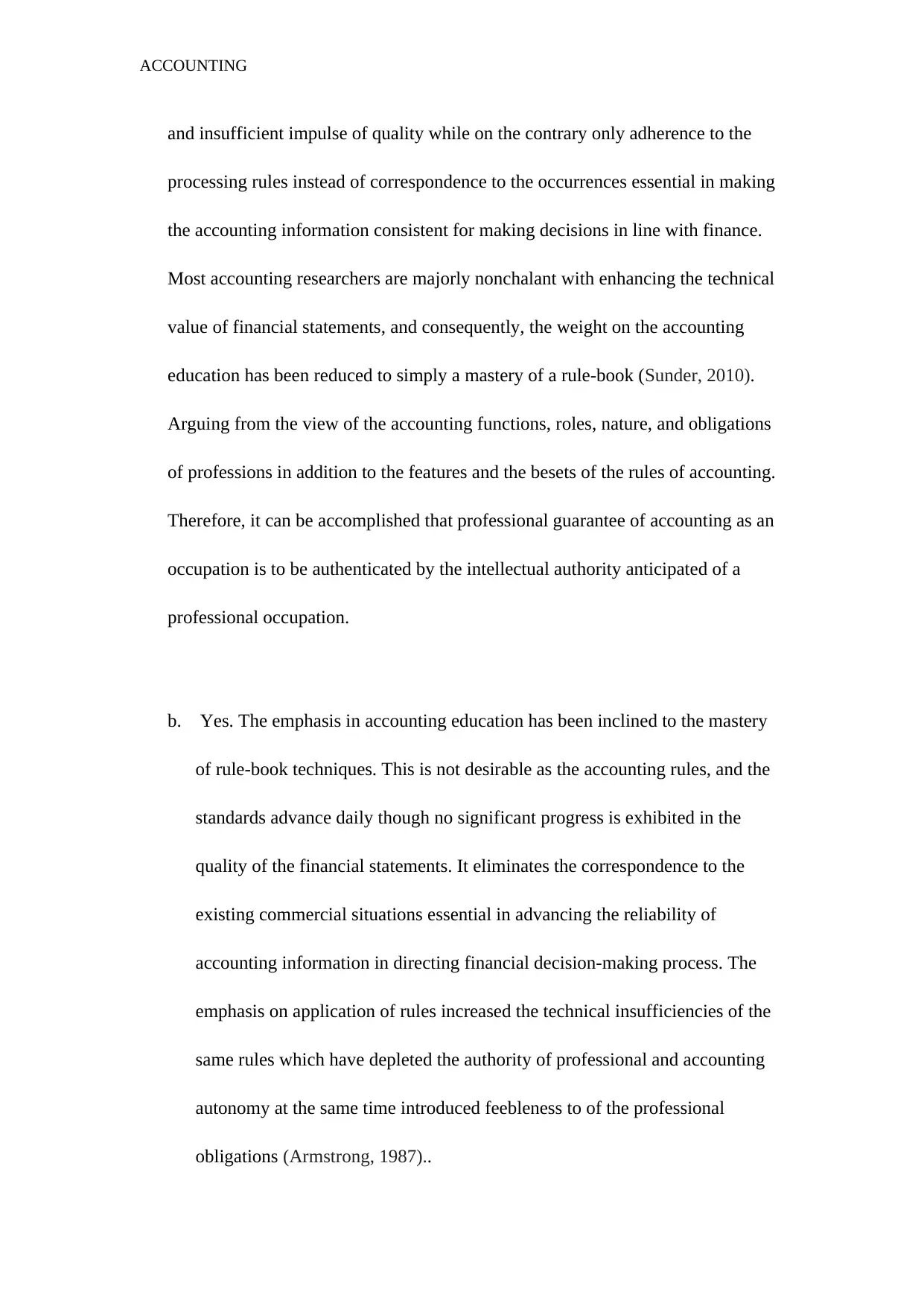
ACCOUNTING
and insufficient impulse of quality while on the contrary only adherence to the
processing rules instead of correspondence to the occurrences essential in making
the accounting information consistent for making decisions in line with finance.
Most accounting researchers are majorly nonchalant with enhancing the technical
value of financial statements, and consequently, the weight on the accounting
education has been reduced to simply a mastery of a rule-book (Sunder, 2010).
Arguing from the view of the accounting functions, roles, nature, and obligations
of professions in addition to the features and the besets of the rules of accounting.
Therefore, it can be accomplished that professional guarantee of accounting as an
occupation is to be authenticated by the intellectual authority anticipated of a
professional occupation.
b. Yes. The emphasis in accounting education has been inclined to the mastery
of rule-book techniques. This is not desirable as the accounting rules, and the
standards advance daily though no significant progress is exhibited in the
quality of the financial statements. It eliminates the correspondence to the
existing commercial situations essential in advancing the reliability of
accounting information in directing financial decision-making process. The
emphasis on application of rules increased the technical insufficiencies of the
same rules which have depleted the authority of professional and accounting
autonomy at the same time introduced feebleness to of the professional
obligations (Armstrong, 1987)..
and insufficient impulse of quality while on the contrary only adherence to the
processing rules instead of correspondence to the occurrences essential in making
the accounting information consistent for making decisions in line with finance.
Most accounting researchers are majorly nonchalant with enhancing the technical
value of financial statements, and consequently, the weight on the accounting
education has been reduced to simply a mastery of a rule-book (Sunder, 2010).
Arguing from the view of the accounting functions, roles, nature, and obligations
of professions in addition to the features and the besets of the rules of accounting.
Therefore, it can be accomplished that professional guarantee of accounting as an
occupation is to be authenticated by the intellectual authority anticipated of a
professional occupation.
b. Yes. The emphasis in accounting education has been inclined to the mastery
of rule-book techniques. This is not desirable as the accounting rules, and the
standards advance daily though no significant progress is exhibited in the
quality of the financial statements. It eliminates the correspondence to the
existing commercial situations essential in advancing the reliability of
accounting information in directing financial decision-making process. The
emphasis on application of rules increased the technical insufficiencies of the
same rules which have depleted the authority of professional and accounting
autonomy at the same time introduced feebleness to of the professional
obligations (Armstrong, 1987)..
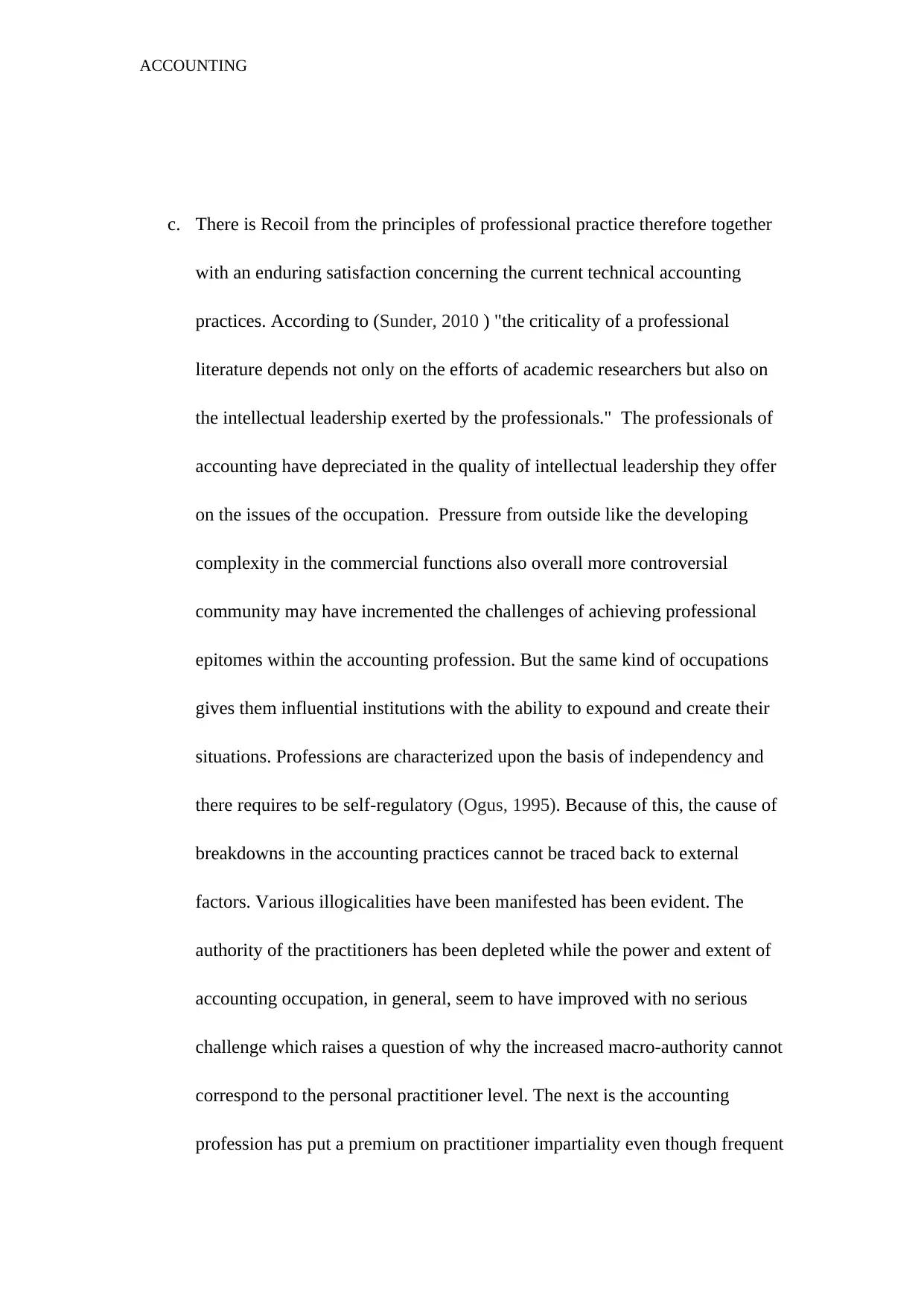
ACCOUNTING
c. There is Recoil from the principles of professional practice therefore together
with an enduring satisfaction concerning the current technical accounting
practices. According to (Sunder, 2010 ) "the criticality of a professional
literature depends not only on the efforts of academic researchers but also on
the intellectual leadership exerted by the professionals." The professionals of
accounting have depreciated in the quality of intellectual leadership they offer
on the issues of the occupation. Pressure from outside like the developing
complexity in the commercial functions also overall more controversial
community may have incremented the challenges of achieving professional
epitomes within the accounting profession. But the same kind of occupations
gives them influential institutions with the ability to expound and create their
situations. Professions are characterized upon the basis of independency and
there requires to be self-regulatory (Ogus, 1995). Because of this, the cause of
breakdowns in the accounting practices cannot be traced back to external
factors. Various illogicalities have been manifested has been evident. The
authority of the practitioners has been depleted while the power and extent of
accounting occupation, in general, seem to have improved with no serious
challenge which raises a question of why the increased macro-authority cannot
correspond to the personal practitioner level. The next is the accounting
profession has put a premium on practitioner impartiality even though frequent
c. There is Recoil from the principles of professional practice therefore together
with an enduring satisfaction concerning the current technical accounting
practices. According to (Sunder, 2010 ) "the criticality of a professional
literature depends not only on the efforts of academic researchers but also on
the intellectual leadership exerted by the professionals." The professionals of
accounting have depreciated in the quality of intellectual leadership they offer
on the issues of the occupation. Pressure from outside like the developing
complexity in the commercial functions also overall more controversial
community may have incremented the challenges of achieving professional
epitomes within the accounting profession. But the same kind of occupations
gives them influential institutions with the ability to expound and create their
situations. Professions are characterized upon the basis of independency and
there requires to be self-regulatory (Ogus, 1995). Because of this, the cause of
breakdowns in the accounting practices cannot be traced back to external
factors. Various illogicalities have been manifested has been evident. The
authority of the practitioners has been depleted while the power and extent of
accounting occupation, in general, seem to have improved with no serious
challenge which raises a question of why the increased macro-authority cannot
correspond to the personal practitioner level. The next is the accounting
profession has put a premium on practitioner impartiality even though frequent
⊘ This is a preview!⊘
Do you want full access?
Subscribe today to unlock all pages.

Trusted by 1+ million students worldwide
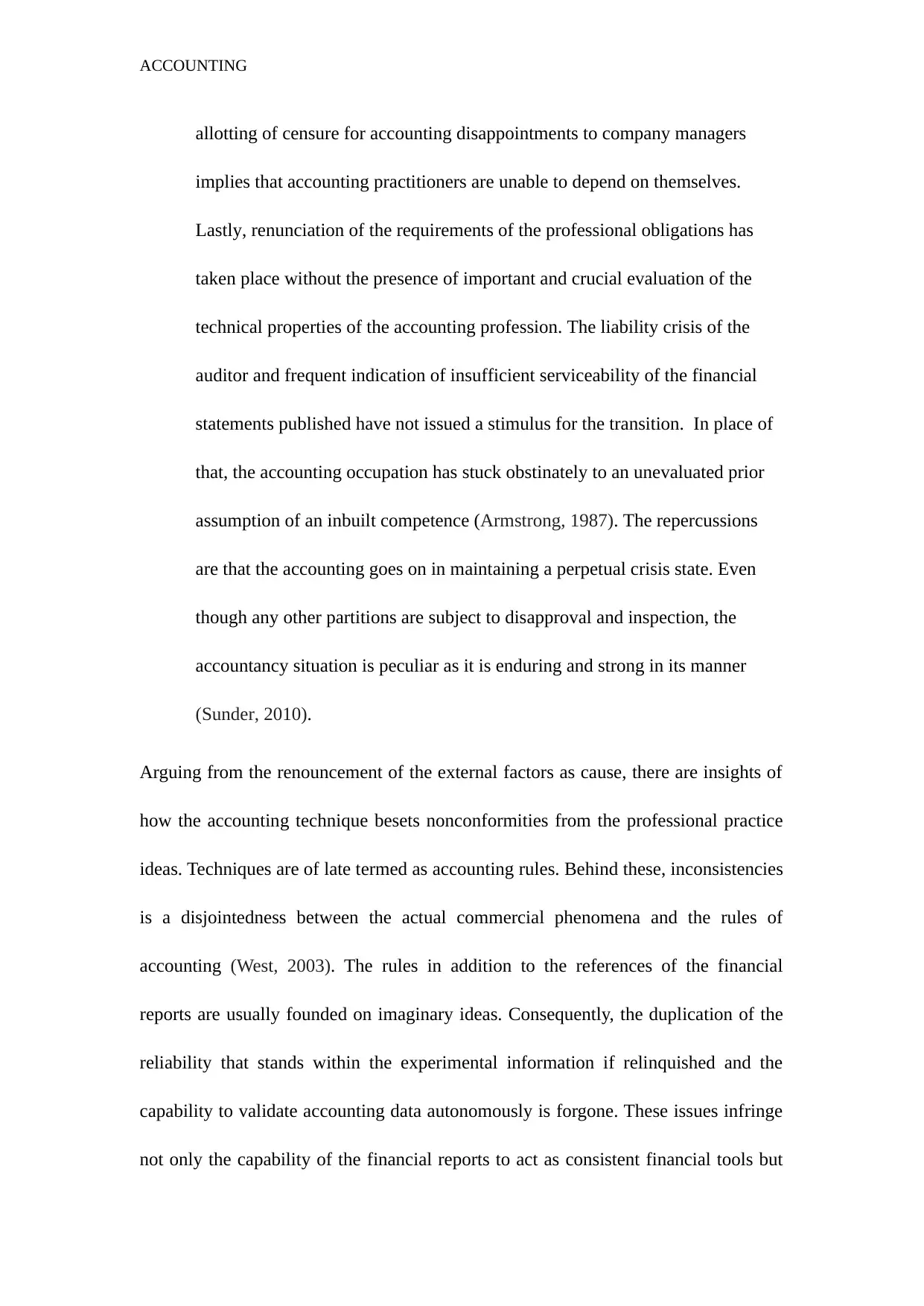
ACCOUNTING
allotting of censure for accounting disappointments to company managers
implies that accounting practitioners are unable to depend on themselves.
Lastly, renunciation of the requirements of the professional obligations has
taken place without the presence of important and crucial evaluation of the
technical properties of the accounting profession. The liability crisis of the
auditor and frequent indication of insufficient serviceability of the financial
statements published have not issued a stimulus for the transition. In place of
that, the accounting occupation has stuck obstinately to an unevaluated prior
assumption of an inbuilt competence (Armstrong, 1987). The repercussions
are that the accounting goes on in maintaining a perpetual crisis state. Even
though any other partitions are subject to disapproval and inspection, the
accountancy situation is peculiar as it is enduring and strong in its manner
(Sunder, 2010).
Arguing from the renouncement of the external factors as cause, there are insights of
how the accounting technique besets nonconformities from the professional practice
ideas. Techniques are of late termed as accounting rules. Behind these, inconsistencies
is a disjointedness between the actual commercial phenomena and the rules of
accounting (West, 2003). The rules in addition to the references of the financial
reports are usually founded on imaginary ideas. Consequently, the duplication of the
reliability that stands within the experimental information if relinquished and the
capability to validate accounting data autonomously is forgone. These issues infringe
not only the capability of the financial reports to act as consistent financial tools but
allotting of censure for accounting disappointments to company managers
implies that accounting practitioners are unable to depend on themselves.
Lastly, renunciation of the requirements of the professional obligations has
taken place without the presence of important and crucial evaluation of the
technical properties of the accounting profession. The liability crisis of the
auditor and frequent indication of insufficient serviceability of the financial
statements published have not issued a stimulus for the transition. In place of
that, the accounting occupation has stuck obstinately to an unevaluated prior
assumption of an inbuilt competence (Armstrong, 1987). The repercussions
are that the accounting goes on in maintaining a perpetual crisis state. Even
though any other partitions are subject to disapproval and inspection, the
accountancy situation is peculiar as it is enduring and strong in its manner
(Sunder, 2010).
Arguing from the renouncement of the external factors as cause, there are insights of
how the accounting technique besets nonconformities from the professional practice
ideas. Techniques are of late termed as accounting rules. Behind these, inconsistencies
is a disjointedness between the actual commercial phenomena and the rules of
accounting (West, 2003). The rules in addition to the references of the financial
reports are usually founded on imaginary ideas. Consequently, the duplication of the
reliability that stands within the experimental information if relinquished and the
capability to validate accounting data autonomously is forgone. These issues infringe
not only the capability of the financial reports to act as consistent financial tools but
Paraphrase This Document
Need a fresh take? Get an instant paraphrase of this document with our AI Paraphraser
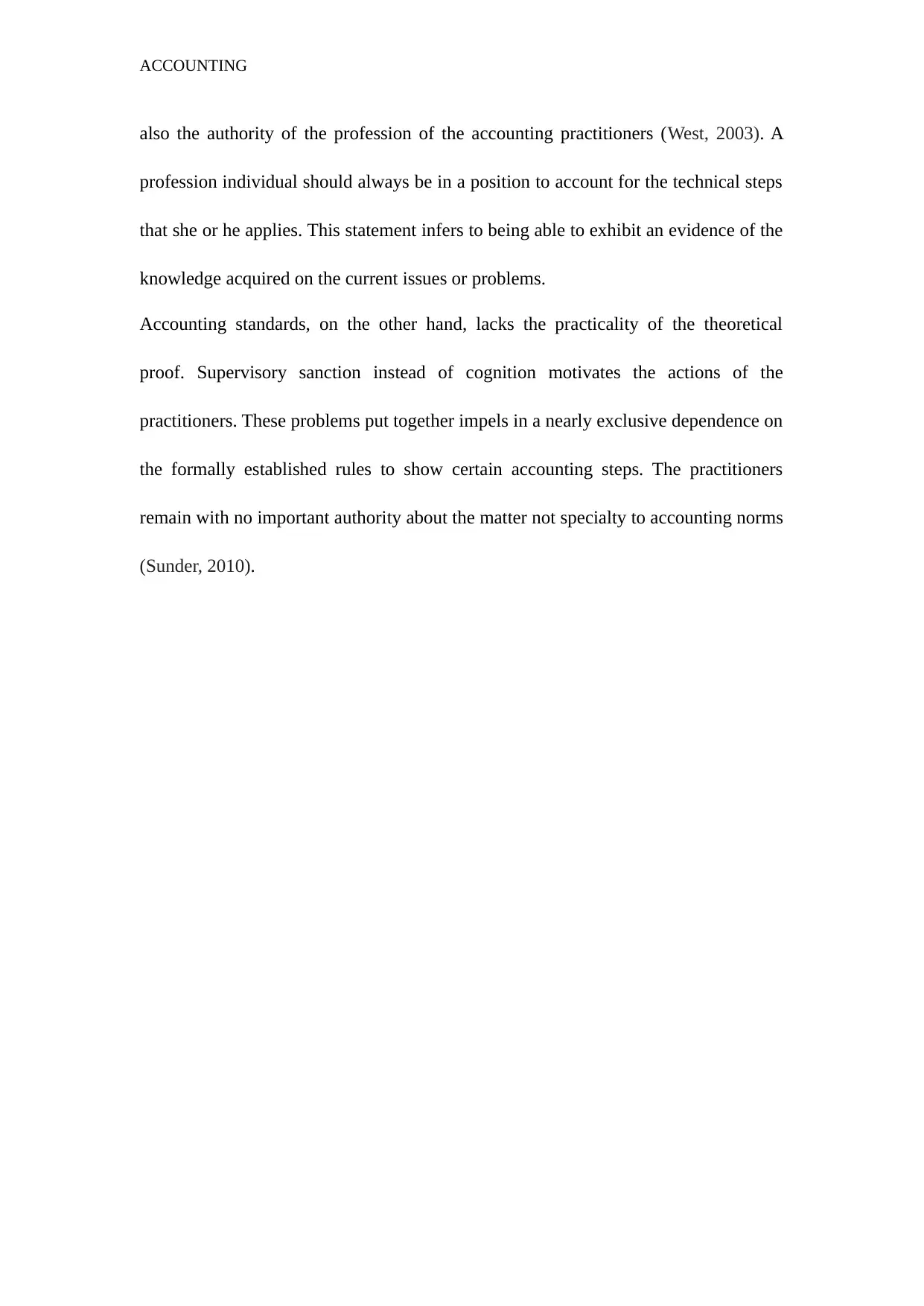
ACCOUNTING
also the authority of the profession of the accounting practitioners (West, 2003). A
profession individual should always be in a position to account for the technical steps
that she or he applies. This statement infers to being able to exhibit an evidence of the
knowledge acquired on the current issues or problems.
Accounting standards, on the other hand, lacks the practicality of the theoretical
proof. Supervisory sanction instead of cognition motivates the actions of the
practitioners. These problems put together impels in a nearly exclusive dependence on
the formally established rules to show certain accounting steps. The practitioners
remain with no important authority about the matter not specialty to accounting norms
(Sunder, 2010).
also the authority of the profession of the accounting practitioners (West, 2003). A
profession individual should always be in a position to account for the technical steps
that she or he applies. This statement infers to being able to exhibit an evidence of the
knowledge acquired on the current issues or problems.
Accounting standards, on the other hand, lacks the practicality of the theoretical
proof. Supervisory sanction instead of cognition motivates the actions of the
practitioners. These problems put together impels in a nearly exclusive dependence on
the formally established rules to show certain accounting steps. The practitioners
remain with no important authority about the matter not specialty to accounting norms
(Sunder, 2010).
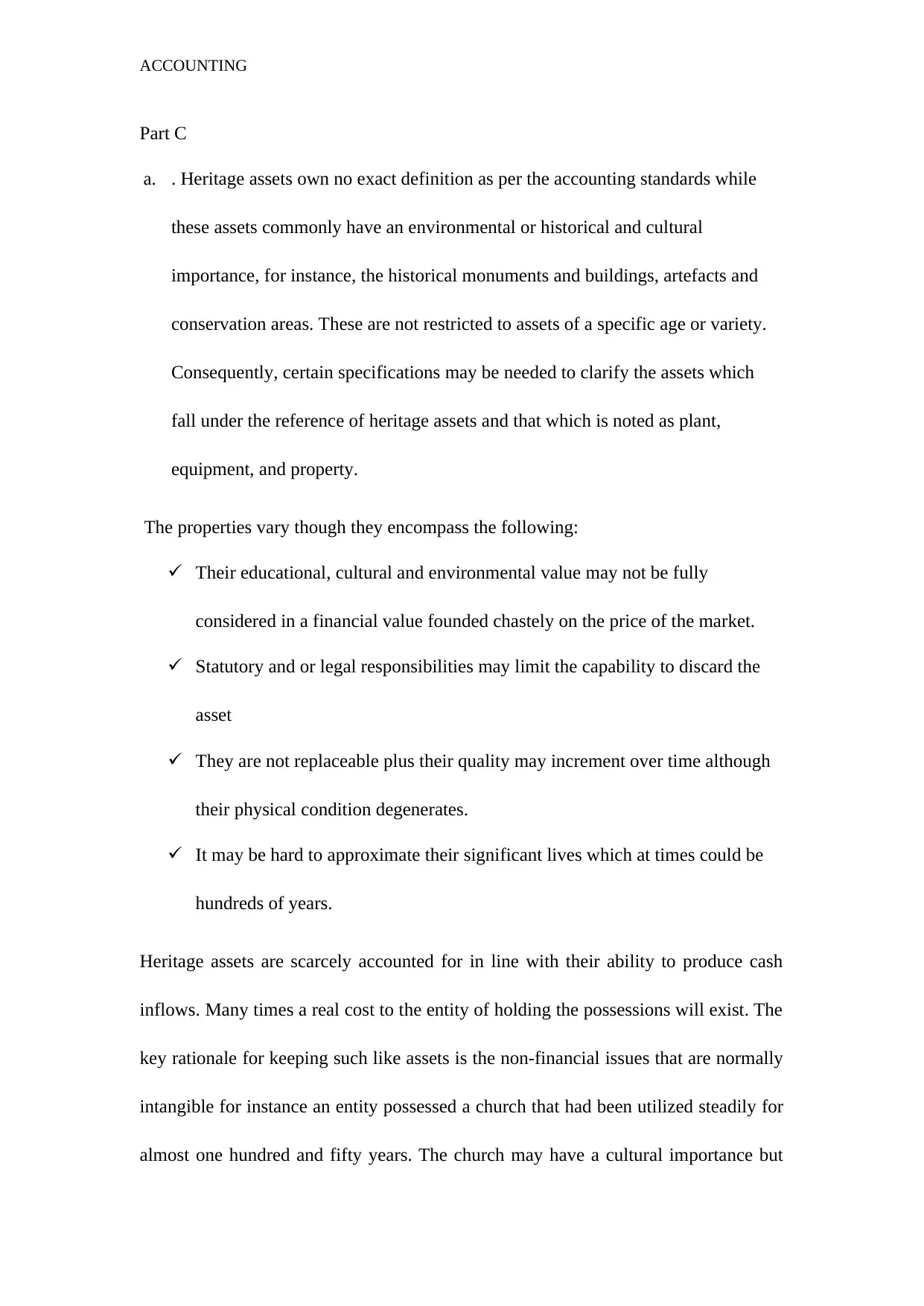
ACCOUNTING
Part C
a. . Heritage assets own no exact definition as per the accounting standards while
these assets commonly have an environmental or historical and cultural
importance, for instance, the historical monuments and buildings, artefacts and
conservation areas. These are not restricted to assets of a specific age or variety.
Consequently, certain specifications may be needed to clarify the assets which
fall under the reference of heritage assets and that which is noted as plant,
equipment, and property.
The properties vary though they encompass the following:
Their educational, cultural and environmental value may not be fully
considered in a financial value founded chastely on the price of the market.
Statutory and or legal responsibilities may limit the capability to discard the
asset
They are not replaceable plus their quality may increment over time although
their physical condition degenerates.
It may be hard to approximate their significant lives which at times could be
hundreds of years.
Heritage assets are scarcely accounted for in line with their ability to produce cash
inflows. Many times a real cost to the entity of holding the possessions will exist. The
key rationale for keeping such like assets is the non-financial issues that are normally
intangible for instance an entity possessed a church that had been utilized steadily for
almost one hundred and fifty years. The church may have a cultural importance but
Part C
a. . Heritage assets own no exact definition as per the accounting standards while
these assets commonly have an environmental or historical and cultural
importance, for instance, the historical monuments and buildings, artefacts and
conservation areas. These are not restricted to assets of a specific age or variety.
Consequently, certain specifications may be needed to clarify the assets which
fall under the reference of heritage assets and that which is noted as plant,
equipment, and property.
The properties vary though they encompass the following:
Their educational, cultural and environmental value may not be fully
considered in a financial value founded chastely on the price of the market.
Statutory and or legal responsibilities may limit the capability to discard the
asset
They are not replaceable plus their quality may increment over time although
their physical condition degenerates.
It may be hard to approximate their significant lives which at times could be
hundreds of years.
Heritage assets are scarcely accounted for in line with their ability to produce cash
inflows. Many times a real cost to the entity of holding the possessions will exist. The
key rationale for keeping such like assets is the non-financial issues that are normally
intangible for instance an entity possessed a church that had been utilized steadily for
almost one hundred and fifty years. The church may have a cultural importance but
⊘ This is a preview!⊘
Do you want full access?
Subscribe today to unlock all pages.

Trusted by 1+ million students worldwide
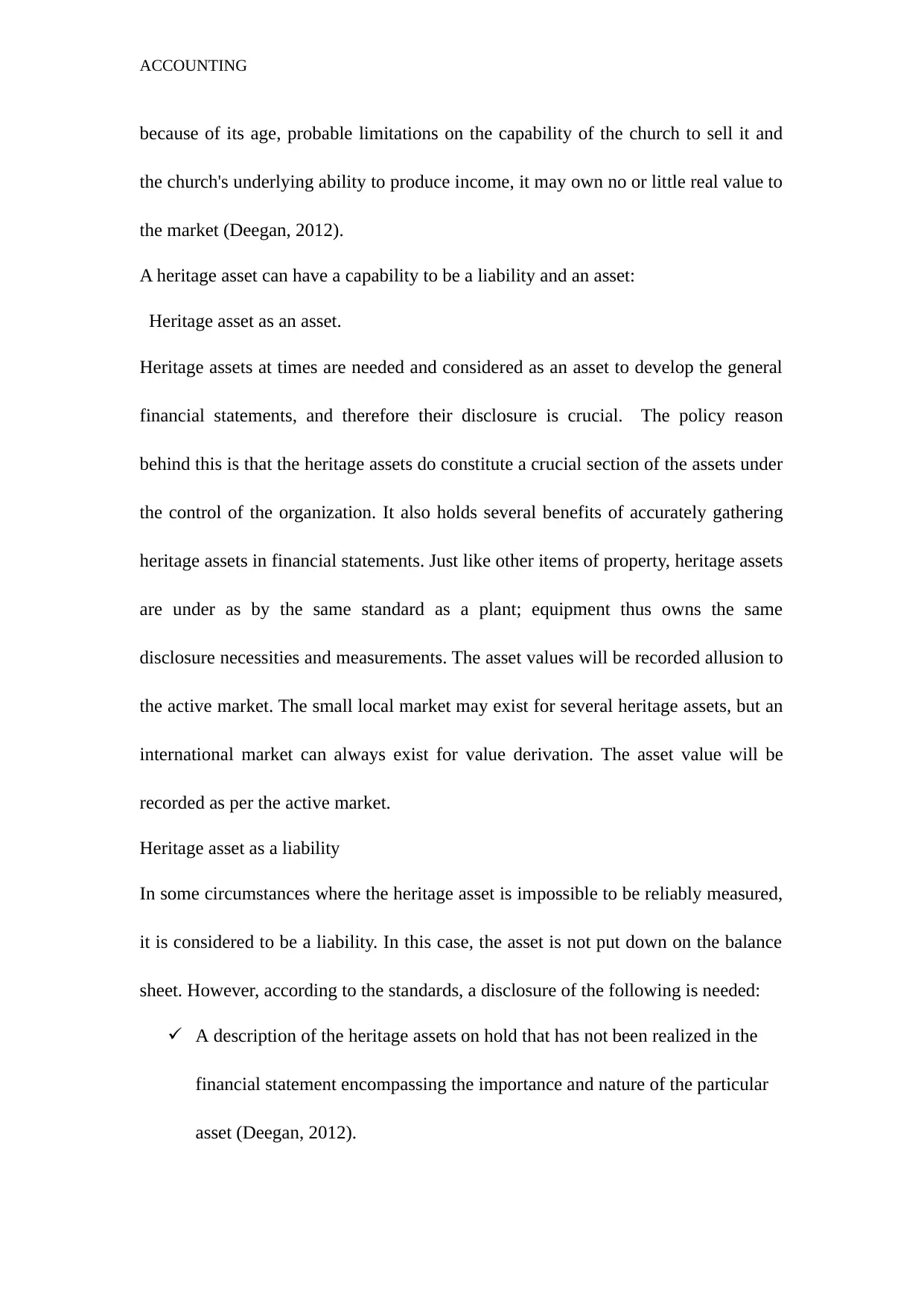
ACCOUNTING
because of its age, probable limitations on the capability of the church to sell it and
the church's underlying ability to produce income, it may own no or little real value to
the market (Deegan, 2012).
A heritage asset can have a capability to be a liability and an asset:
Heritage asset as an asset.
Heritage assets at times are needed and considered as an asset to develop the general
financial statements, and therefore their disclosure is crucial. The policy reason
behind this is that the heritage assets do constitute a crucial section of the assets under
the control of the organization. It also holds several benefits of accurately gathering
heritage assets in financial statements. Just like other items of property, heritage assets
are under as by the same standard as a plant; equipment thus owns the same
disclosure necessities and measurements. The asset values will be recorded allusion to
the active market. The small local market may exist for several heritage assets, but an
international market can always exist for value derivation. The asset value will be
recorded as per the active market.
Heritage asset as a liability
In some circumstances where the heritage asset is impossible to be reliably measured,
it is considered to be a liability. In this case, the asset is not put down on the balance
sheet. However, according to the standards, a disclosure of the following is needed:
A description of the heritage assets on hold that has not been realized in the
financial statement encompassing the importance and nature of the particular
asset (Deegan, 2012).
because of its age, probable limitations on the capability of the church to sell it and
the church's underlying ability to produce income, it may own no or little real value to
the market (Deegan, 2012).
A heritage asset can have a capability to be a liability and an asset:
Heritage asset as an asset.
Heritage assets at times are needed and considered as an asset to develop the general
financial statements, and therefore their disclosure is crucial. The policy reason
behind this is that the heritage assets do constitute a crucial section of the assets under
the control of the organization. It also holds several benefits of accurately gathering
heritage assets in financial statements. Just like other items of property, heritage assets
are under as by the same standard as a plant; equipment thus owns the same
disclosure necessities and measurements. The asset values will be recorded allusion to
the active market. The small local market may exist for several heritage assets, but an
international market can always exist for value derivation. The asset value will be
recorded as per the active market.
Heritage asset as a liability
In some circumstances where the heritage asset is impossible to be reliably measured,
it is considered to be a liability. In this case, the asset is not put down on the balance
sheet. However, according to the standards, a disclosure of the following is needed:
A description of the heritage assets on hold that has not been realized in the
financial statement encompassing the importance and nature of the particular
asset (Deegan, 2012).
Paraphrase This Document
Need a fresh take? Get an instant paraphrase of this document with our AI Paraphraser
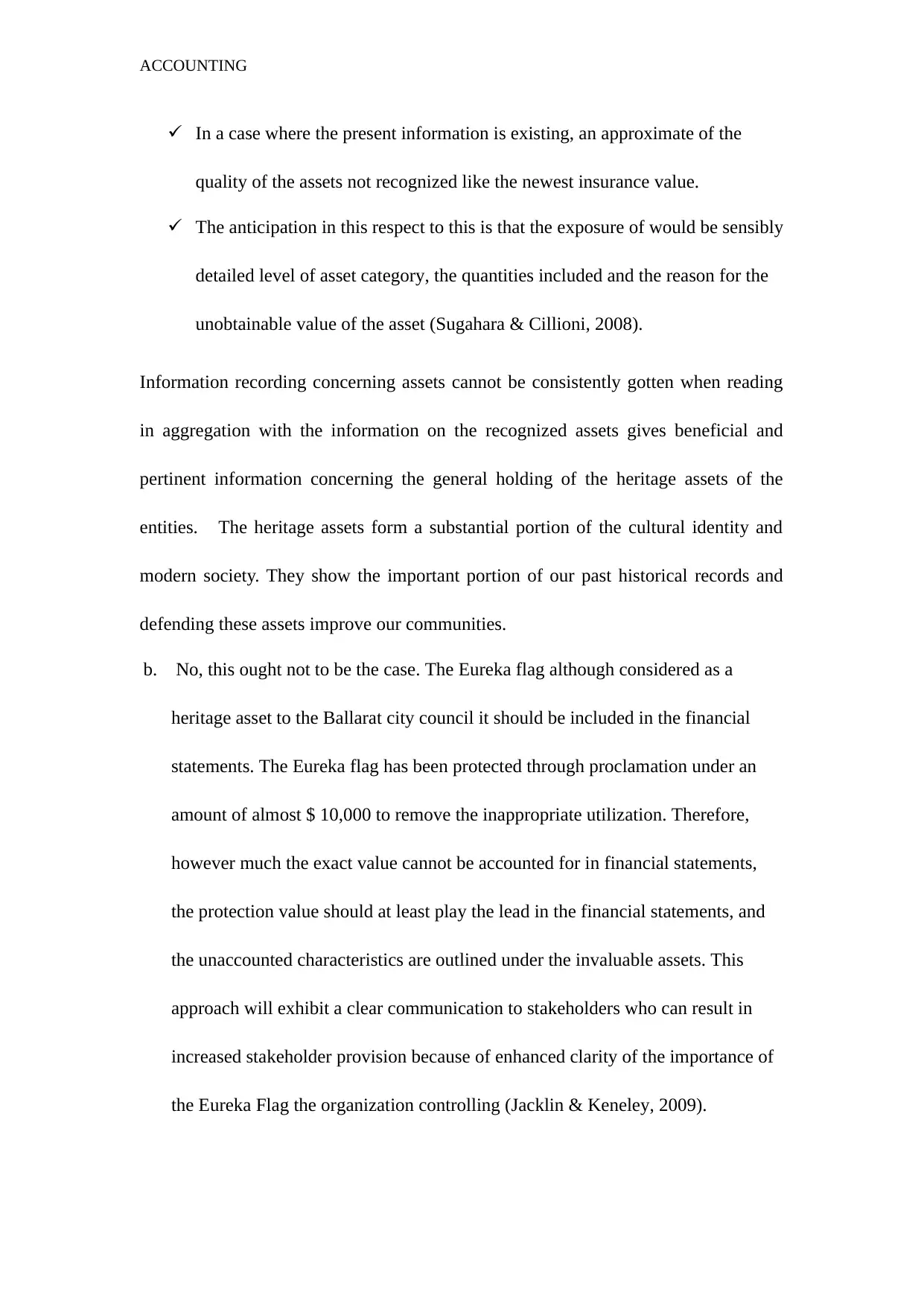
ACCOUNTING
In a case where the present information is existing, an approximate of the
quality of the assets not recognized like the newest insurance value.
The anticipation in this respect to this is that the exposure of would be sensibly
detailed level of asset category, the quantities included and the reason for the
unobtainable value of the asset (Sugahara & Cillioni, 2008).
Information recording concerning assets cannot be consistently gotten when reading
in aggregation with the information on the recognized assets gives beneficial and
pertinent information concerning the general holding of the heritage assets of the
entities. The heritage assets form a substantial portion of the cultural identity and
modern society. They show the important portion of our past historical records and
defending these assets improve our communities.
b. No, this ought not to be the case. The Eureka flag although considered as a
heritage asset to the Ballarat city council it should be included in the financial
statements. The Eureka flag has been protected through proclamation under an
amount of almost $ 10,000 to remove the inappropriate utilization. Therefore,
however much the exact value cannot be accounted for in financial statements,
the protection value should at least play the lead in the financial statements, and
the unaccounted characteristics are outlined under the invaluable assets. This
approach will exhibit a clear communication to stakeholders who can result in
increased stakeholder provision because of enhanced clarity of the importance of
the Eureka Flag the organization controlling (Jacklin & Keneley, 2009).
In a case where the present information is existing, an approximate of the
quality of the assets not recognized like the newest insurance value.
The anticipation in this respect to this is that the exposure of would be sensibly
detailed level of asset category, the quantities included and the reason for the
unobtainable value of the asset (Sugahara & Cillioni, 2008).
Information recording concerning assets cannot be consistently gotten when reading
in aggregation with the information on the recognized assets gives beneficial and
pertinent information concerning the general holding of the heritage assets of the
entities. The heritage assets form a substantial portion of the cultural identity and
modern society. They show the important portion of our past historical records and
defending these assets improve our communities.
b. No, this ought not to be the case. The Eureka flag although considered as a
heritage asset to the Ballarat city council it should be included in the financial
statements. The Eureka flag has been protected through proclamation under an
amount of almost $ 10,000 to remove the inappropriate utilization. Therefore,
however much the exact value cannot be accounted for in financial statements,
the protection value should at least play the lead in the financial statements, and
the unaccounted characteristics are outlined under the invaluable assets. This
approach will exhibit a clear communication to stakeholders who can result in
increased stakeholder provision because of enhanced clarity of the importance of
the Eureka Flag the organization controlling (Jacklin & Keneley, 2009).
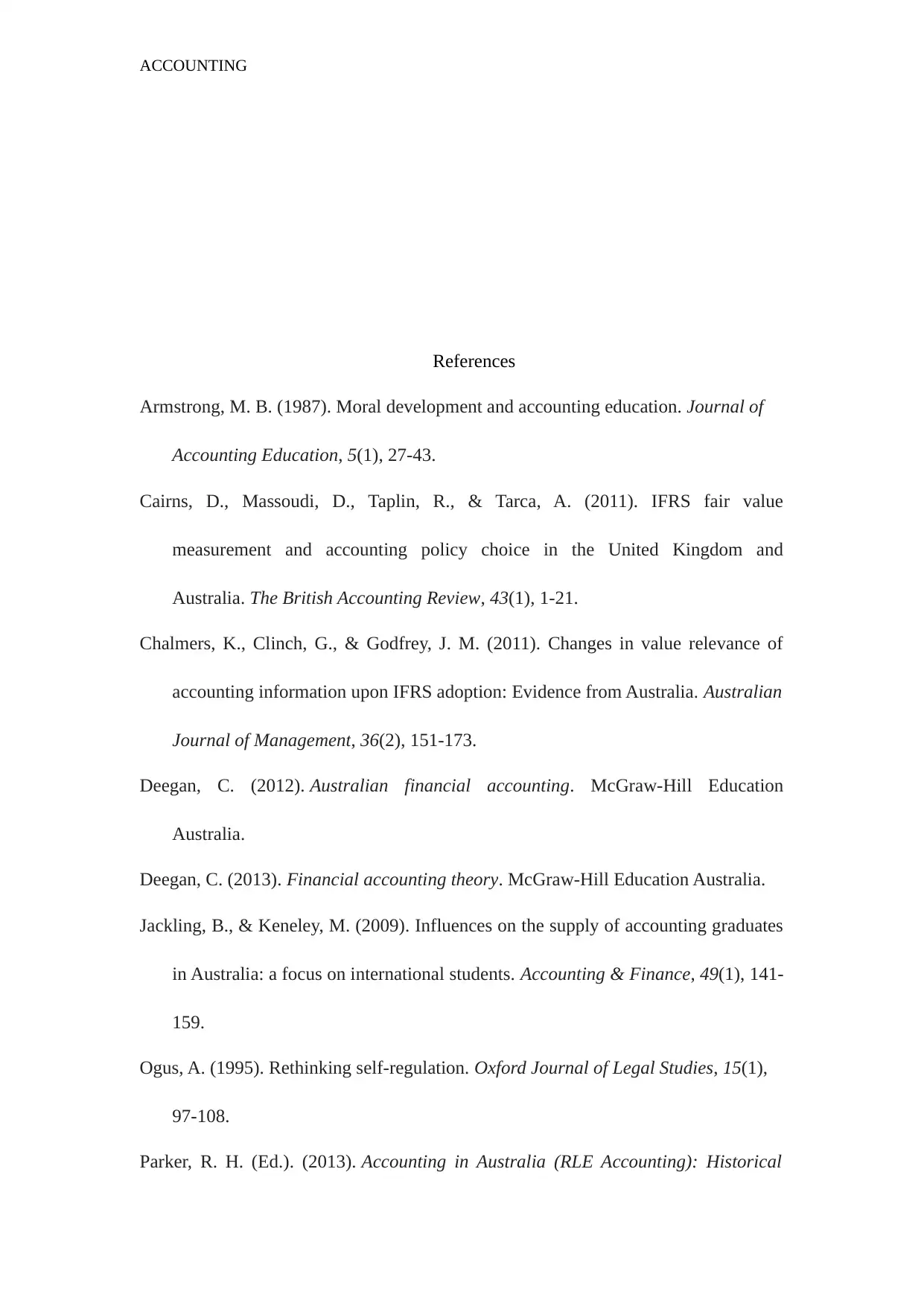
ACCOUNTING
References
Armstrong, M. B. (1987). Moral development and accounting education. Journal of
Accounting Education, 5(1), 27-43.
Cairns, D., Massoudi, D., Taplin, R., & Tarca, A. (2011). IFRS fair value
measurement and accounting policy choice in the United Kingdom and
Australia. The British Accounting Review, 43(1), 1-21.
Chalmers, K., Clinch, G., & Godfrey, J. M. (2011). Changes in value relevance of
accounting information upon IFRS adoption: Evidence from Australia. Australian
Journal of Management, 36(2), 151-173.
Deegan, C. (2012). Australian financial accounting. McGraw-Hill Education
Australia.
Deegan, C. (2013). Financial accounting theory. McGraw-Hill Education Australia.
Jackling, B., & Keneley, M. (2009). Influences on the supply of accounting graduates
in Australia: a focus on international students. Accounting & Finance, 49(1), 141-
159.
Ogus, A. (1995). Rethinking self-regulation. Oxford Journal of Legal Studies, 15(1),
97-108.
Parker, R. H. (Ed.). (2013). Accounting in Australia (RLE Accounting): Historical
References
Armstrong, M. B. (1987). Moral development and accounting education. Journal of
Accounting Education, 5(1), 27-43.
Cairns, D., Massoudi, D., Taplin, R., & Tarca, A. (2011). IFRS fair value
measurement and accounting policy choice in the United Kingdom and
Australia. The British Accounting Review, 43(1), 1-21.
Chalmers, K., Clinch, G., & Godfrey, J. M. (2011). Changes in value relevance of
accounting information upon IFRS adoption: Evidence from Australia. Australian
Journal of Management, 36(2), 151-173.
Deegan, C. (2012). Australian financial accounting. McGraw-Hill Education
Australia.
Deegan, C. (2013). Financial accounting theory. McGraw-Hill Education Australia.
Jackling, B., & Keneley, M. (2009). Influences on the supply of accounting graduates
in Australia: a focus on international students. Accounting & Finance, 49(1), 141-
159.
Ogus, A. (1995). Rethinking self-regulation. Oxford Journal of Legal Studies, 15(1),
97-108.
Parker, R. H. (Ed.). (2013). Accounting in Australia (RLE Accounting): Historical
⊘ This is a preview!⊘
Do you want full access?
Subscribe today to unlock all pages.

Trusted by 1+ million students worldwide
1 out of 13
Related Documents
Your All-in-One AI-Powered Toolkit for Academic Success.
+13062052269
info@desklib.com
Available 24*7 on WhatsApp / Email
![[object Object]](/_next/static/media/star-bottom.7253800d.svg)
Unlock your academic potential
Copyright © 2020–2025 A2Z Services. All Rights Reserved. Developed and managed by ZUCOL.





